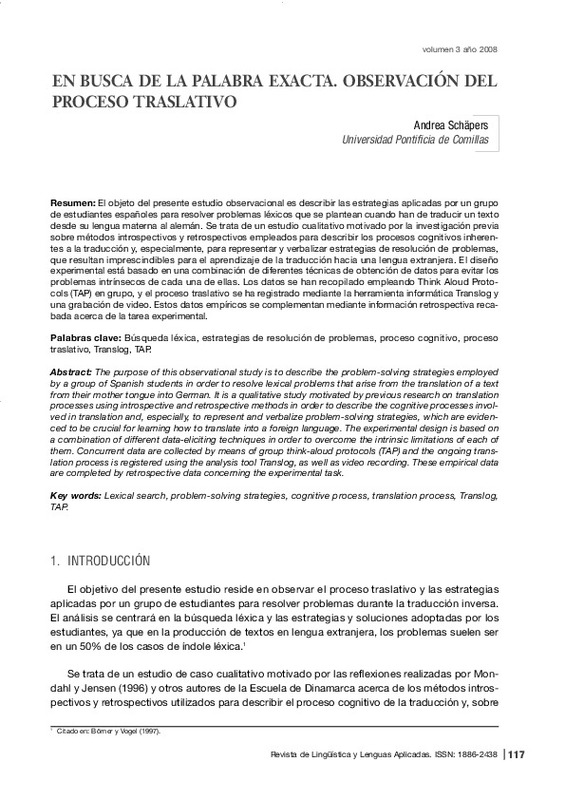JavaScript is disabled for your browser. Some features of this site may not work without it.
Buscar en RiuNet
Listar
Mi cuenta
Estadísticas
Ayuda RiuNet
Admin. UPV
EN BUSCA DE LA PALABRA EXACTA. OBSERVACIÓN DEL PROCESO TRASLATIVO
Mostrar el registro sencillo del ítem
Ficheros en el ítem
| dc.contributor.author | Schäpers, Andrea
|
|
| dc.date.accessioned | 2011-04-01T10:59:14Z | |
| dc.date.available | 2011-04-01T10:59:14Z | |
| dc.date.issued | 2008 | |
| dc.identifier.issn | 1886-2438 | |
| dc.identifier.uri | http://hdl.handle.net/10251/10634 | |
| dc.description.abstract | [EN] The purpose of this observational study is to describe the problem-solving strategies employed by a group of Spanish students in order to resolve lexical problems that arise from the translation of a text from their mother tongue into German. It is a qualitative study motivated by previous research on translation processes using introspective and retrospective methods in order to describe the cognitive processes involved in translations and, especially, to represent and verbalize problem-solving strategies, which are evidenced to be crucial for learning how to translate into a foreign language. The experimental design is based on a combination of different data-elicting techniques in order to overcome the intrinsic limitations of each of them. Concurrent data are collected by means of group think-aloud protocols (TAP) and the ongoing translation process is registered using the analysis tool Translog, as well as video recording. These empirical data are completed by retrospective data concerning the experimental task. | es_ES |
| dc.description.abstract | [ES] El objeto del presente estudio observacional es describir las estrategias aplicadas por un grupo de estudiantes españoles para resolver problemas léxicos que se plantean cuando han de traducir un texto desde su lengua materna al alemán. Se trata de un estudio cualitativo motivado por la investigación previa sobre métodos introspectivos y retrospectivos empleados para describir los procesos cognitivos inherentes a la traducción y , especialmente, para representar y verbalizar estrategias de resolución de problemas , que resultan imprescindibles para el aprendizaje de la traducción hacia una lengua extranjera. El diseño experimental está basado en una combinación de diferentes técnicas de obtención de datos para evitar los problemas intrínsecos de cada una de ellas . Los datos se han recopilado empleando Think Aloud Protocols (T A P ) en grupo, y el proceso traslativo se ha registrado mediante la herramienta informática Translog y una grabación de video. Estos datos empíricos se complementan mediante información retrospectiva recabada acerca de la tarea experimental. | |
| dc.language | Español | es_ES |
| dc.publisher | Editorial Universitat Politècnica de València | es_ES |
| dc.relation.ispartof | Revista de Lingüística y Lenguas Aplicadas | |
| dc.rights | Reserva de todos los derechos | es_ES |
| dc.subject | Búsqueda léxica | es_ES |
| dc.subject | Estrategias de resolución de problemas | es_ES |
| dc.subject | Proceso cognitivo | es_ES |
| dc.subject | Proceso traslativo | es_ES |
| dc.subject | Translog | es_ES |
| dc.subject | TAP | es_ES |
| dc.title | EN BUSCA DE LA PALABRA EXACTA. OBSERVACIÓN DEL PROCESO TRASLATIVO | es_ES |
| dc.type | Artículo | es_ES |
| dc.date.updated | 2011-03-31T13:33:55Z | |
| dc.identifier.doi | 10.4995/rlyla.2008.695 | |
| dc.rights.accessRights | Abierto | es_ES |
| dc.description.bibliographicCitation | Schäpers, A. (2008). EN BUSCA DE LA PALABRA EXACTA. OBSERVACIÓN DEL PROCESO TRASLATIVO. Revista de Lingüística y Lenguas Aplicadas. 3:117-127. https://doi.org/10.4995/rlyla.2008.695 | es_ES |
| dc.description.accrualMethod | SWORD | es_ES |
| dc.relation.publisherversion | http://doi.org/10.4995/rlyla.2008.695 | |
| dc.description.upvformatpinicio | 117 | |
| dc.description.upvformatpfin | 127 | |
| dc.description.volume | 3 | |
| dc.identifier.eissn | 1886-6298 | es_ES |








